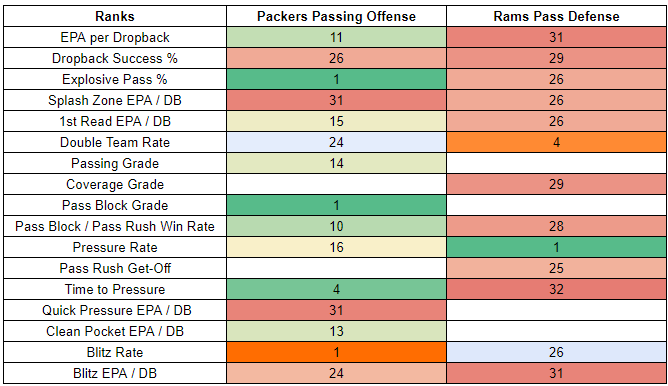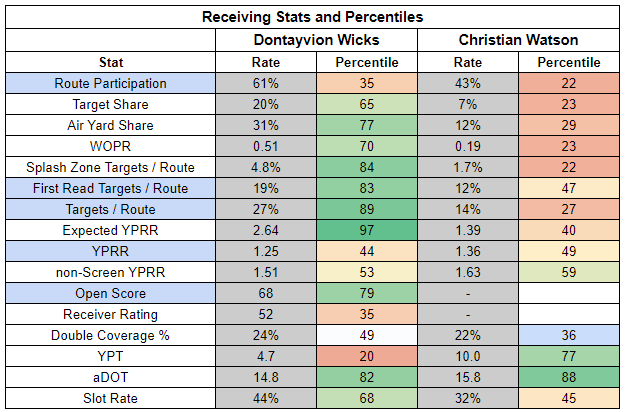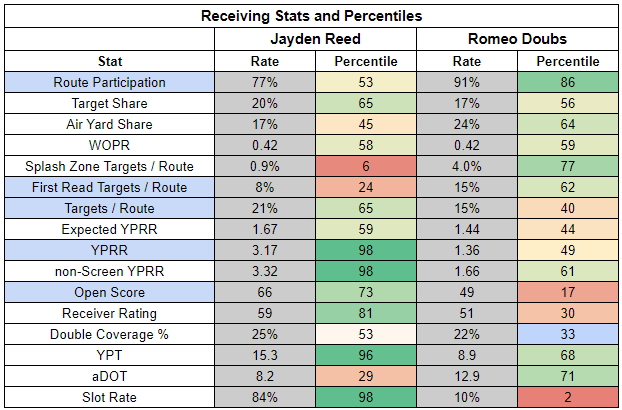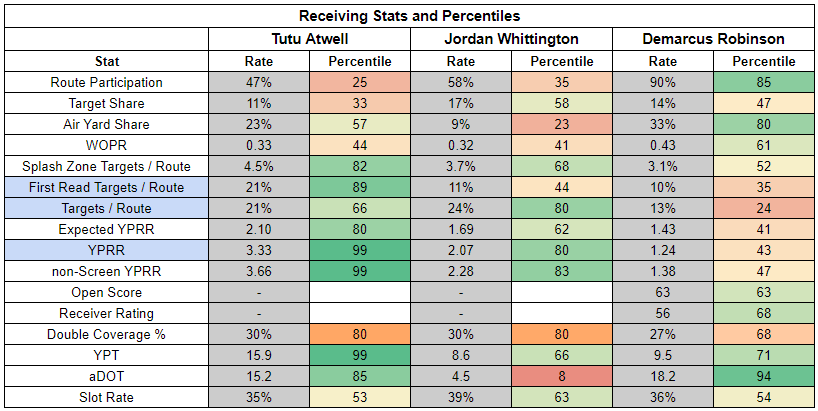
Week 5 Walkthrough: Dontayvion's Inferno
Welcome to the Week 5 Walkthrough.
In this article, I'll outline critical fantasy football context for the fifth glorious football Sunday.
(The stats below are from PFF, NFLfastR, rbsdm.com, RotoViz, FantasyLabs, Fantasy Points, ESPN, and NFL Next Gen).
Quick Links
- Packers at Rams, 4:25 PM
- Jets at Vikings, 9:30 AM, London
- Ravens at Bengals, 1 PM
- Panthers at Bears, 1 PM
- Dolphins at Patriots, 1 PM
- Browns at Commanders, 1 PM
- Colts at Jaguars, 1 PM
- Bills at Texans, 1 PM
- Cardinals at 49ers, 4:05 PM
- Raiders at Broncos, 4:05 PM
- Giants at Seahawks, 4:25 PM
Packers at Rams, 4:25 PM
Packers Implied Team Total: 26
Despite a productive comeback effort against the Vikings, Jordan Love has been pretty mediocre in both of his games this season.

So from a season-long perspective, he looks unimpressive.

Of course, Love’s season-long sample is only half that of most 2024 starting QBs. And one of those two games was against a very effective Vikings defense.
This week, Love gets a much less formidable Rams defense.

The Rams are getting pressure at the highest rate in the league… but with a time to pressure of just 3.03 seconds, the slowest in the league.
Pressuring quarterbacks quickly is much more disruptive than giving them 3+ seconds to throw before getting home—which is why the Rams are the worst defense in EPA allowed per pressured dropback.
Stunningly, the Rams are actually allowing positive EPA on pressured dropbacks, at 0.30 EPA allowed per pressured dropback. The Jaguars are the only other team in the positive (0.07).
0.30 EPA allowed per dropback is bad. In fact, get this: the Rams are actually worse when they get pressure than when they don’t. With a clean pocket, Los Angeles is averaging just 0.24 EPA allowed per dropback.
And just to underline this, if you include all plays league-wide with a QB dropback, only the Washington Commanders have a worse EPA allowed (0.31) than the Rams when they get “pressure.”
It’s fair to say that although the Rams technically pressure at a high rate… their pass rush is anything but disruptive.
The Rams also have a vulnerable secondary, ranking just 29th in coverage grade and 26th in explosive pass rate against.
That’s a pretty terrible combination against an aggressive downfield passer like Jordan Love.

And we finally have some clarity in the Packers downfield passing game. With Christian Watson sidelined by an ankle injury, Dontayvion Wicks is set to take over as the top deep threat in the offense. And Wicks has already been flashing high-end target upside – sporting an impressive 19% first-read target rate, and a very strong 27% TPRR. The Packers are making Wicks a key part of the game plan and he’s earning targets on his own.
The missing piece of the puzzle is per-target efficiency. With just a 4.7 YPT, Wicks has left a lot of yards on the field. This isn’t even really a Malik Willis stat, as Wicks has numerous missed connections with Love—including drops and a play against the Eagles where he slipped coming back to the ball.
But Wicks is getting targeted frequently, he’s getting targeted deep, and he’s getting open. This is a perfect matchup for him to deliver on that high-upside combination.

Another nice thing about this matchup is that if the Rams are able to put up points and push the Packers, they look very willing to pass. In two losses with Love under center, the Packers have posted 64% and 76% pass rates.

Even if the Packers play from ahead here, they should have enough passing efficiency and volume to support multiple weapons.
That's nice to see since, as excited as I am about Wicks, I don’t want to bet against Jayden Reed in this spot. Reed’s per-target efficiency has been out of this world (15.3 YPT) and is a lock to regress. But he’s flashing serious target-earning ability – which is not going anywhere. And I expect Reed to be a bigger part of this week’s game plan than his 8% first-read target rate would suggest.

Romeo Doubs is also in play—provided he plays after missing Thursday's practice. The big selling point is routes, which is never very fun. But he’s also getting targeted in the splash zone, which is a nice fit for this matchup.
At tight end, Tucker Kraft is coming off elite 86% route participation. He looks locked in as the Packers TE1. The targets are still lagging, but he’s been an impressive route runner, and is a very solid play here.

Against the run, the Rams aren’t any more impressive than against the pass.

The issue for Josh Jacobs is in his own backfield. Emmanuel Wilson has worked into a meaningful role.

Meanwhile, Jacobs is more of a 1A at this point than a clear-cut starter.

The good news is that Jacobs has been much more explosive this season than in his final year with the Raiders. He’s adding almost nothing as a receiver, but he’s a borderline RB1 play as a bet on efficiency and game environment.

Rams Implied Team Total: 23
Despite not having Puka Nacua and Cooper Kupp for much of the year, Matthew Stafford has been remarkably consistent. He hasn't been super efficient, but he looks very similar to Patrick Mahomes, Jared Goff, and Tua Tagovailoa. Given the context, that’s pretty damn impressive.

Stafford now gets a Packers defense that ranks just 28th in success rate allowed. They’re also allowing big plays.

Ordinarily, I’d view Stafford as a positive regression candidate. And he will be… if his consistency is sustained until one or both of his elite WRs returns. But for now, he’s making do with Tutu Atwell as his top target. Atwell has stepped up, but much of his production is driven by an unsustainable 15.9 YPT.
Stafford needs another weapon to surface, with Demarcus Robinson struggling to deliver on his high-end route volume.
It looks like Jordan Whittington could be that guy. His 4.5 aDOT creates a nice complement to Atwell’s deep routes, and he’s shown an ability to earn targets – posting a 24% TPRR. Whittington logged a team-high 97% route participation against the Bears, so his opportunity has truly arrived. Both he and Atwell are very much in play here as a bet on these teams pushing each other.

Colby Parkinson is less interesting… but he’s running a lot of routes.

For the Rams to hit high-end pass volume, they probably will need to be pushed. They’ve been leaning on the run this year, even if it means fighting the game script a bit.

That sets up Kyren Williams for another big workload. Williams’ rushing yardage efficiency has been truly awful this year—and he’s adding nothing in the passing game.

But Williams is punching in those TDs, keeping him level with his lofty expected points workload – despite his continuing rushing woes.
This week he gets a Packers run defense that has a poor run-stopping line, but is also showing up when it counts – ranking second in EPA allowed per run.

I don’t expect Williams to be very efficient here—but I don’t see the Packers as a shutdown run defense, either. So, while he’s not the elite RB1 his workload suggests, he’s still pretty close.
Jets at Vikings, 9:30 AM, London
Jets Implied Team Total: 19
Last week, I noted that Aaron Rodgers would be facing a blitz-happy Broncos defense—playing to one of Rodgers' strengths and likely forcing defensive coordinator Vance Joseph to rely less on one of his favorite tactics.
That’s not what happened. Joseph didn’t seem worried about Rodgers’ ability to punish him for sending heat; he blitzed Rodgers on 49% of snaps, the third-highest rate of the week.
Uncharacteristically, Rodgers was not good against the blitz – at all. He averaged -0.50 EPA per blitzed dropback. That’s worse than Deshaun Watson (-0.28), Bo Nix (-0.35), and Will Levis (-0.46) have been on their average dropback – blitzed or not – this year. So Joseph’s game plan succeeded in turning Rodgers into one of the least effective passers in the league.

Rodgers now faces Brian Flores, who is going to love what he sees on that Week 4 tape. Flores is blitzing at the third-highest rate in the league, and the Vikings have been effective when sending extra defenders.

After his poor outing against the Broncos, Rodgers looks more Dalton-esque than we’d prefer. But he’s still turning in solid efficiency.

Also, Rodgers is generally well-suited to go against the blitz – because he gets the ball out very quickly. Among passers with 50+ dropbacks, only Andy Dalton (2.35 seconds), Tua Tagovailoa (2.40), and Baker Mayfield (2.44) have a quicker time-to-throw (TTT) than Rodgers (2.52).

And the Jets have been willing to pass when the game script dictates it. Nathaniel Hackett has a lot of flaws… but at least he’s not stubbornly running the ball in passing situations.

The issue for us as fantasy players is that, even if Rodgers bounces back in another biltz-happy matchup, his weapons look far less exciting than we’d hoped when drafting them this summer.
Garrett Wilson has a solid 23% TPRR, but his connection with Rodgers just hasn’t been there so far – yielding a poor 5.6 YPT and a 1.26 YPRR.
Even worse, Wilson has just a 1.10 YPRR against the blitz, with a middling 24% TPRR.
By comparison, in his last season in Green Bay, soon-to-be-Jet? Davante Adams had a 2.81 YPRR and an 30% TPRR on all routes. Against the blitz, Adams posted a very similar 2.77 YPRR—with an elevated 37% TPRR.
Eventually, Rodgers may come to rely on Wilson as his clear go-to target in pressure situations. But we don’t appear to be anywhere near the Rodgers-Adams connection just yet.
Fundamentally, the Vikings defense is a tough matchup – so I don’t expect this to be the game where Rodgers and Wilson level up. And we really do need Wilson to step things up. His eighth percentile open score is genuinely shocking, since his bull case rests on his ability to create separation.

At tight end, it’s worth noting that Tyler Conklin leads the position in route participation. But he’s just not a part of the game plan.

And the Vikings aren’t just effective against the pass – they’ve also been very impressive against the run.

That’s not great news for Breece Hall, who is struggling as a rusher this season.

It’s especially bad news, given that Braelon Allen has been more consistent—while acing the eye test—and delivering similar per-route receiving contributions to Hall’s.

Hall is a very explosive runner, which hasn’t been on display much this season, but should keep him meaningfully ahead of Allen in the backfield hierarchy. Still, Allen projects to be a real thorn in Hall's side going forward—especially if Allen takes on more short-yardage work.
The one positive note here is that Rodgers is throwing to his RBs at a high rate, including against the blitz. So Hall has a chance to rebound from his Week 4 dud with more receiving work in London, even if he struggles again to get going on the ground.
Vikings Implied Team Total: 21.5
We’re nearly a quarter of the way through the regular season… and Sam Darnold looks like one of the best QBs in the league.

Darnold is also one of the most fun QBs in the league. Specifically, he’s attacking the splash zone – 10+ yards downfield and over the middle – which is a great way to facilitate YAC plays for his receivers. He’s also attacking downfield generally, with an 8.3 aDOT, and he’s been very efficient at that—with a 7.2 average depth of completion and a 6% completion percentage over expected (CPOE).

Darnold’s big weakness as a passer is that he’s taking a long time to get the ball out. Only Brock Purdy (3.14 seconds) and Jalen Hurts (3.10) have a slower TTT than Darnold (3.07).
That could create some issues for him against a Jets defense that is pressuring effectively, while excelling in coverage.

But if betting on Darnold, we have Kevin O’Connell in our corner. In addition to designing a highly effective passing game, O’Connell is showing a willingness to pass. Despite finding themselves in extremely run-heavy game scripts, the Vikings are operating like the Cardinals and Commanders – rather than running game true-believers like the Saints and Chargers.

The Vikings have been in consistently positive game scripts this year, but they’ve hinted at a willingness to open up the offense more, if pushed.

This creates a wide range of outcomes for the Vikings passing offense. This game could be a defensive battle, with limited and ineffective passing on both sides. It could also be a game where we finally see the Vikings top a 60% pass rate.
And if we get more passing volume, it will magnify Justin Jefferson’s elite offensive role. Jefferson has been seeing a ton of double coverage, but it isn’t slowing him down at all. Instead, he’s delivering elite efficiency—while also opening up big-play opportunities for Jordan Addison in single coverage.

Addison has taken advantage of those opportunities so far, though his 2.43 YPRR significantly overstates his role in the offense. Still, he’s not a bad bet for downfield production here.
This is a spot where we should stick to the Vikings’ primary weapons. Although the Vikings appear willing to open things up more if pushed, the “pushed” part is no guarantee. And if operating from ahead, the Vikings should be pretty keen on attacking a weak Jets run defense.

And not only are the Jets weak against the run, they’re shaping up as a major run funnel.

This sets up Aaron Jones as a very nice play, given the soft matchup. Plus, in addition to running the ball well, Jones is also a big part of the passing game—insulating him from game script issues. He’s an RB1.

Part of Jones’ appeal is that Ty Chandler has been a big disappointment so far this year. There’s very little reason not to feature Jones for as long as this type of disparity exists.



